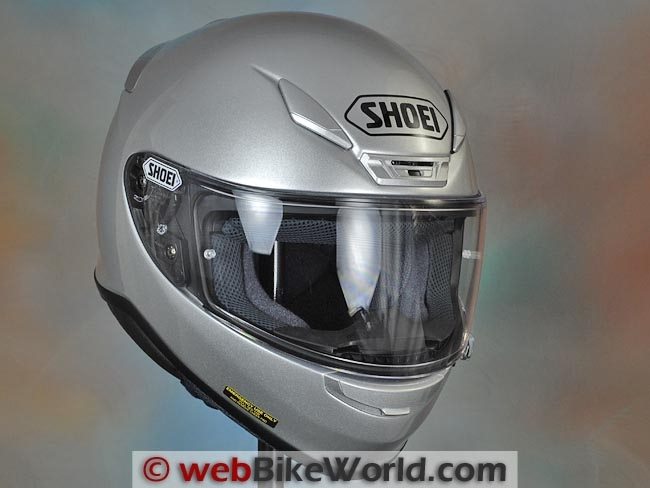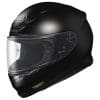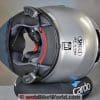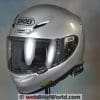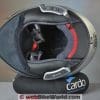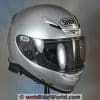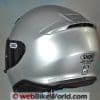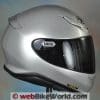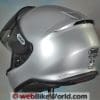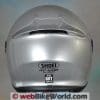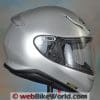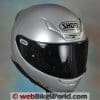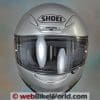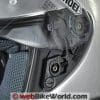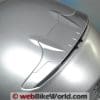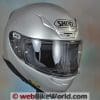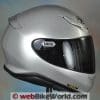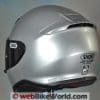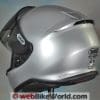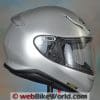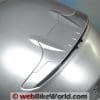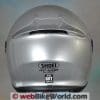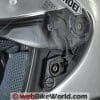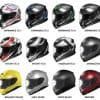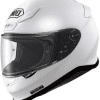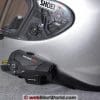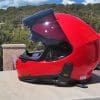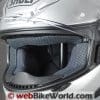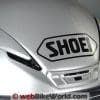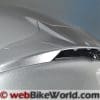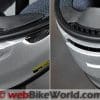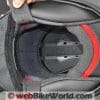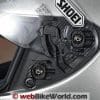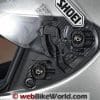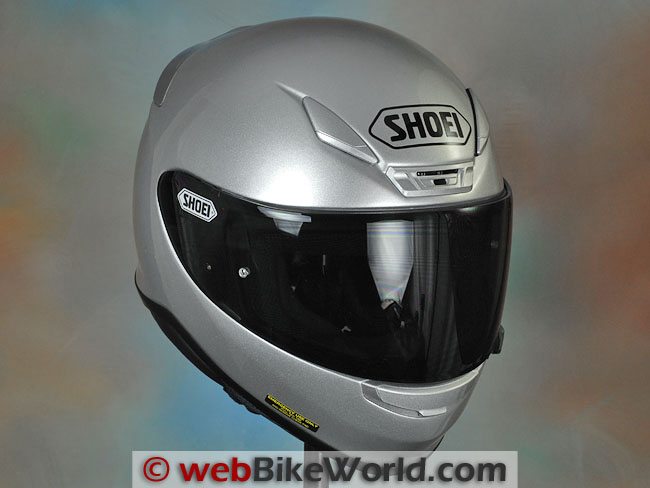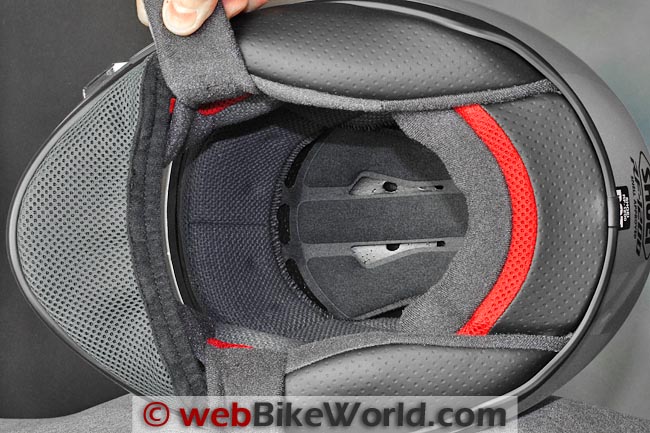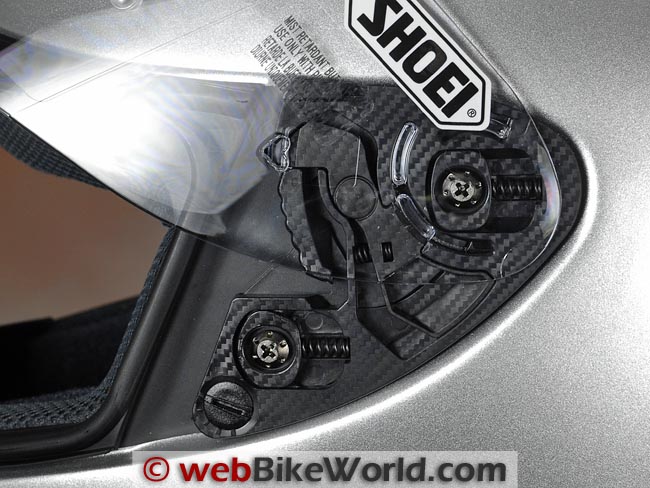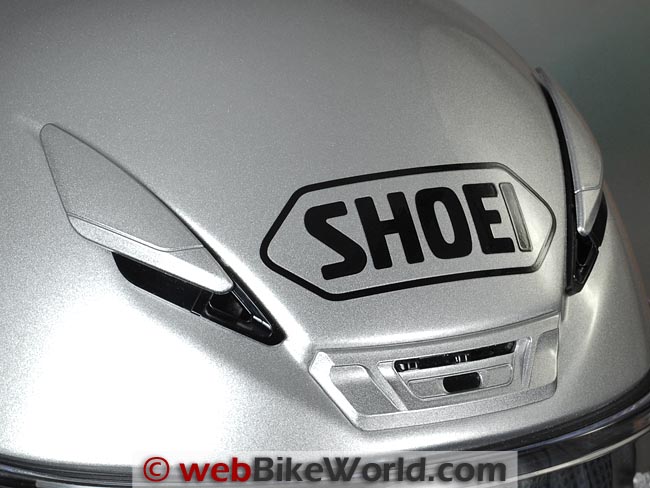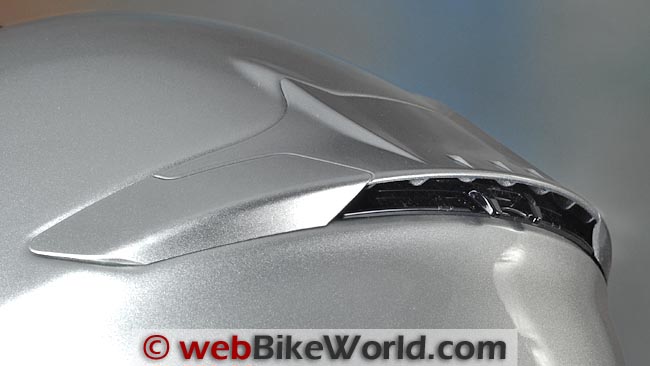The Shoei RF-1200 is the latest iteration of the very popular and venerable RF-series. It’s an all-around sport, sport-touring and streetbike helmet that comes in lots of different colors and graphics and it spans 4 shell sizes in an XS to XXL head size range.
The DOT version of the RF-1200 is also Snell 2010 certified and the fit, finish, overall quality and feel of this helmet are second to none. The shell feels super-solid and combined with the close tolerances for the vents (and the metallic silver finish on ours), the RF-1200 seems for all the world like it was carved from a solid block of metal.
But…but…the RF-1200 now competes with the fabulous Shoei GT Air (review), which has superb ventilation and very low noise levels, plus an internal sun visor. Granted, the GT Air has a list price about $65.00 more than the RF-1200; however, the added features may be worth the extra dosh.
The RF-1200 does generate more noise than I’d hoped it would in some circumstances, however, and the ventilation just doesn’t seem to match the GT Air. Shoei RF fans are sure to be pleased with the new design, however, which is a definite improvement over the RF-1100. The Shoei RF-1200 is officially announced to the world today (October 14) and you’re reading the world’s first review!
See Also: Helmet Buyers Guide, Helmet Review Home and all Shoei Helmet Reviews.
Background
Shoei has been on a tear in 2013 and the RF-1200 is just the latest exampleThe RF-series has been Shoei’s “bread and butter” helmets, with a lineage going all the way back to the RF-102 in 1983. I’m not sure if there were RF-200 to RF-700 helmets, but I do remember the RF-800 and one of my favorites, the Shoei RF-1000 (review) of 2003.
More recently, in 2009, the Shoei RF-1100 (review) was introduced, and although a nice helmet, I didn’t quite mind meld with it. It seemed big and heavy and the vents were a bit clumsy.
While I can’t say that Shoei listened to my complaints particularly, they did listen to their customers and the result is the 2014 Shoei RF-1200.
It’s lighter, trimmer and has a an outstanding build quality, with very close tolerances on all of the various bits and pieces.
The Shoei RF-1200: Paint, Graphics and Overall Quality
Being the “bread and butter” helmet for Shoei, the RF-1200 has to satisfy many different customer requirements and demands. One of those is the variety of color choices.
I opted for plain ol’ metallic silver for my RF-1200, which I thought would better capture the curves and lines in our photographs. Motorcycle helmet photography is tricky at best, so neutral solid colors usually work best.
While a silver metallic paint color may seem a bit boring when compared to the other colors and graphics available for the RF-1200, ours has a stunning finish, with tiny sparkling metallic points and zero flaws in the deep paint and clearcoat.
The paint on our helmet is noticeably better than any other silver metallic helmet we’ve featured recently in webBikeWorld reviews.
It’s hard to believe that silver metallic paint can be so different, but it is — like the difference between a custom paint shop and, well, a spray can.
Don’t like silver? No problem! The RF-1200 comes in a wide range of graphics and colors, including the popular yellow and “Shine Red”, both of which are highly visible.
Here’s a look at the current palette, taken from the Shoei RF-1200 press announcement:
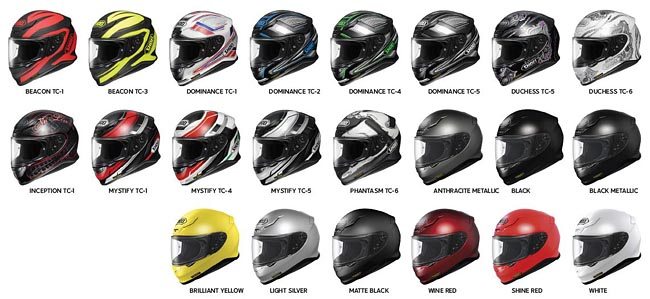
As soon as I lifted the RF-1200 from the box, I noticed that it feels like it’s carved from a bloom of aluminum. The chin vent, the rear exhaust vent and the gasket around the bottom of the helmet all have very tight contact lines where they are attached or assembled to the helmet shell. This also gives the helmet a modern and clean look, despite the fact that there’s nothing too unusual with the shell shape.
The chin vents, top vent and the newly added brow vent snap open and close with a precise feel also and it just demonstrates that this is the goodness you pay for when you fork over around five C-notes for a motorcycle helmet. The liner and padding doesn’t disappoint either; it’s plush and comfortable in typical Shoei fashion. A large chin curtain is included in the box, along with a Pinlock anti-fog insert.
The RF-1200 helmet shell comes in a very generous four sizes for the relatively limited head size range of XS to XXL.
This is a big bonus; it means that owners should be able to have a much more proportional fit between their head size and the helmet shell size, avoiding that “space helmet” look.
The shell is the Shoei AIM+ composite and this one meets the DOT safety standard in the U.S. and it’s also Snell certified to M2010, unlike the Shoei GT Air (review), which is DOT only.
This makes the shell feel very stiff; in fact, it has near zero flex, which is either good or not, depending on your views of the Snell standard.
But one thing’s for sure: the fit, finish and that seemingly no-flex shell — along with the silver aluminum color on ours — all give the Shoei RF-1200 that carved-from-billet feel.
Score: The Shoei RF-1200 gets an “Outstanding” rating from us for paint and overall quality. See the Summary Table at the bottom of the page for a description of our rating system.
-
The Shoei RF-1200 with the optional (and very dark) tinted visor.
-
Standard comfy and removable Shoei helmet liner. Large chin curtain is installed by the owner.
Shoei RF-1200 Fit, Sizing and Internal Shape
We’ve noticed that all of the recent Shoei helmets have what really can now be called the “Shoei fit” (“Neutral” to “Slightly Narrow”) and the RF-1200 is no exception.
The “Shoei fit” is an internal shape that is biased towards the “Slight Narrow” part of the spectrum (as described in the webBikeWorld Motorcycle Helmet Shapes page), with narrower sides and lots of fore/aft room in the top.
The RF-1200 has a different overall shell shape profile than the GT Air, which means that the size large RF-1200 fits over my bulb-shaped head where the size large GT Air did not.
The GT Air has a very narrow taper towards the bottom of the helmet; so narrow, in fact, that I couldn’t fit it over my head without tearing my ears off, so I had to return it for an XL.
| Shoei RF-1200 Shell Size Chart | |
|---|---|
| This Head Size… | …Uses This Shell Size |
| XS, S | XS |
| M | M |
| L | L |
| XL, XXL | XL |
The RF-1200 shell shape or profile is more relaxed and the size large fits me, although it’s still a bit tight.
Shoei hasn’t published their estimations of head sizes for the various helmet sizes yet, so I’m not sure what they’ll recommend.
But my feeling is that the RF-1200 works best for “Slightly Narrow” head shapes of 59 to 60 cm, with a possible 60.5 to 61.0 cm head squeezing in, depending on your helmet comfort zone.
Note that different sized cheek pads will be available also to customize the fit, within reason.
The padding and liner feel comfortable and it’s more or less standard Shoei quality, if perhaps not quite as plush as I remember in the GT Air.
The liner in the RF-1200 is very nicely finished and you can see that around the ear pockets, where care has obviously been taken — yet another sign of a quality helmet and one more feature that you pay for when you spring for an expensive helmet.
The ear pockets feel very slightly too small for me in this size large, but that has more to do with the slight mis-match between the internal shape of the RF-1200 (“Slight Narrow”) and my “Round” head shape.
Intercom speakers should fit nicely, however, and I think a standard intercom mount can be fitted between the shell and EPS but we didn’t try it.
Those tight manufacturing tolerances may make it difficult to squeeze an intercom mount up under the shell, but I think it can be done.
I am able to fit a pair of straight-temple eyeglasses into the helmet, even though the sides of the helmet are very snug on my head shape, again due to the differences in the helmet internal shape and my head.

Overall, we rate the Shoei RF-1200 as very comfortable, especially for “Slight Narrow” head shapes, which are said to be the most common.
More information on helmet fit can be found in the webBikeWorld Motorcycle Helmet FAQ page.
There is also a chart that lists the helmet weights of webBikeWorld reviewed helmets and also by shape on the webBikeWorld Motorcycle Helmet Shapes page.
Score: The Shoei RF-1200 gets an “Outstanding” rating for comfort and liner materials and padding and a comfortable fit.
Shoei RF-1200 Face Shield, Eye Port and Visibility
The visibility out the front of the eye port on the of the RF-1200 is better than average in the horizontal plane and perhaps slightly better than average in the vertical plane.
The face shield quality helps and it feels very solid and tight. Shoei designed a new CWR-1 face shield for the RF-1200, along with a new QR-E base plate system to hold the face shield in place and tight against the also-new eye port gasket.
The face shield now has thick horizontal ribs molded along the top and bottom for extra rigidity.
They measure a massive (for a motorcycle helmet face shield) 3.41 mm thick on our helmet, while the main body of the face shield measures 2.45 mm thick, which is also thicker than average.
The rigidity pretty much removes any flex and the face shield snaps open and closed very tightly. We count a total of 8 opening position detents, after the shield is popped open from the newly designed snap lock under the lift tab.
The face shield can be lifted off the lock slightly and rested just on top of it for a tiny defogging position, or opened to the first detent, which is a larger city/slow speed or more serious defogging position.
The newly designed base plate feels very tight and it maintains a strong gasket seal when the face shield is closed. Again, it all adds to the solid and sturdy ambience of this helmet, although we wish the lifting detents were just a bit sharper.
When you look closely at the molding, the corners were deliberately rounded, probably to make it easier to lift the helmet through the detents, but sometimes it can be just a bit difficult to get the helmet to stop at the desired height.
The optical quality of the face shield is outstanding but, unlike our Shoei GT Air, it’s not marked as meeting the VESC-8 spec.
However, it does say “Made in the USA” and we’d guess with near certainty that the manufacturer is MXL Industries in Pennsylvania, which I visited back in 2007 and described in my report “How to Make a Motorcycle Helmet Visor”.
MXL Industries made the visors and face shields for Shoei to their stringent quality requirements back then and I assume they still are today.
The RF-1200 does not have an internal sun visor, which is just fine with me, but this is where it differs again from the GT Air.
The thick, full-surround eye port gasket on the RF-1200 positively sealed out water in this helmet.
That was both in the webBikeWorld “Leakdown Test” and during my rides over the last 5 days, which have seen a massive 7″ of rainfall in the Mid-Atlantic, breaking an extended mini-drought. I had no leaks from the vents or visor when riding in the rain.

Score: The Shoei RF-1200 gets an “Outstanding” rating for the overall quality and operation of the face shield.
-
Shoei RF-1200 top vents and brow vent.
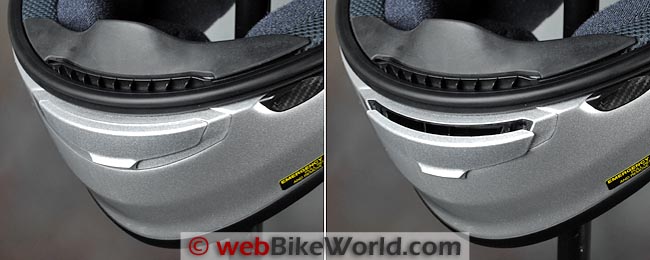
-
Shoei RF-1200 rear exhaust vent.
Ventilation and Air Flow
It would be difficult to beat the outstanding Shoei GT Air for ventilation and, unsurprisingly, the RF-1200 doesn’t. It’s not bad, mind you; just that the GT Air ventilation is so good that other helmets pale in comparison.
We were pleased with the ventilation in the Shoei RF-1100 (review) but the RF-1200 doesn’t seem to have made much of an improvement, despite the addition of the new brow vent and 6 holes through the EPS at the top of the liner, with no liner padding covering them.
The problem seems to be the orientation of the holes, which appear to be at least at right angles and possible at oblique angles to the flow of air from the vents at the top/front part of the helmet.
The air flows in and I can sort of feel it, but it’s nowhere close to the immediate and powerful upper ventilation of the GT Air.
The RF-1200 chin vent, however, works very well, although no air is vented directly through the chin bar.
When the chin vent is opened, the air is immediately felt along the top of the chin bar, where it flows upward and through a pair of narrow vents at the top of the eye port.
Riding in the rain, I did not feel the need for the Pinlock insert, which I didn’t install. The RF-1200 chin vent kept the inside of the face shield clear.
The rear exhaust vent has a slider to open or close the port. But — as most of these do — it seems superfluous, because even with the intake vents closed, the exhaust port is usually left open to reduce internal air pressure and get some ventilation.
Overall, the ventilation system on the RF-1200 is good, but not outstanding, especially when compared to the GT Air.

Score: The RF-1200 ventilation system rates an “Excellent” overall.
Shoei RF-1200 Noise Levels
Here’s where it gets complicated. The RF-1200 is disappointing when it comes to noise control.
First, the good: riding a motorcycle without a fairing or windscreen (i.e. a “naked” bike), the RF-1200 was relatively quiet but has some wind noise generated by the top vents when they are open.
The top vent noise is especially noticeable when sitting upright, where the air passes over the vent holes similar to blowing over a soda bottle. The noise is reduced quite a bit if the head is tilted forward when riding a sport-tourer or sportbike.
But when riding behind a windscreen that directs air at the helmet, I notice quite a bit of loud, mid-to-low range wind noise all around the outside of the helmet.
I tried to isolate the noise by blocking the wind, adding wind-blocking neck rolls.
I also tried two different touring bikes plus the BMW C 650 GT Scooter (blog), but always ended up with the same result: a loud, mid-to-low range wind noise that seems to come from all around the helmet.
So my conclusion is that the RF-1200 may not be ideal for riding a touring bike or on any motorcycle where the windscreen directs air at any portion of the helmet from about 1/3 down from the top to around the bottom.
This is a common problem with motorcycle helmets but seems especially noticeable on the RF-1200.
To put it another way, the RF-1200 doesn’t come close to the very low noise levels of the GT Air under the same riding conditions.
The GT Air is one of the quietest helmets we’ve ever reviewed in a variety of environments, plus it has outstanding ventilation — among the best we’ve ever experienced.

Note that our helmet evaluations are a combined effort of several riders over time on different types of motorcycles with and without windscreens.
Evaluators wear correctly fitted, high quality ear plugs (even when evaluating motorcycle intercom systems).
Always protect your hearing when riding a motorcycle. See the wBW Earplug Reviews for more information on choosing and wearing earplugs.
Note also that perceived noise levels will vary, depending on the individual.
Noise can be caused by many factors, including helmet fit, the type of motorcycle and windscreen, wind speed and direction and even the rider’s clothing.
For more information on helmet noise, visit the wBW Motorcycle Helmet Noise page.
Score: This is a tough one, but the Shoei RF-1200 is disappointing for noise control. I’ll give it a “Neutral” rating.
wBW Video: Shoei RF-1200 Helmet
Helmet Weight
This Shoei RF-1200 in size Large weighs 1608 grams, not bad for a helmet that meets the DOT standard and is also Snell certified. It feels a bit lighter than it is and has good balance and aerodynamics.
In comparison, the Shoei RF-1000 (review) in size XL weighed 1610 grams; the Arai Vector 2 (review) in size L weighted 1611 grams; the Bell RS-1 (review) in size L weighted 1603 grams and the Arai RX-Q (review) in size L weighed 1597 grams.
The Shoei X-12 (review) weighed 1766 grams and the Shoei RF-1100 (review) in size XL weighed 1746 grams.
Note also that all of the helmets reviewed on webBikeWorld have been weighed and the weights are available on the wBW Motorcycle Helmet Weights page.
Also, there is a chart that lists the helmets by weight and shape on the wBW Motorcycle Helmet Shapes page.
Score: The Shoei RF-1200 gets a “Very Good” rating for its weight and good balance.
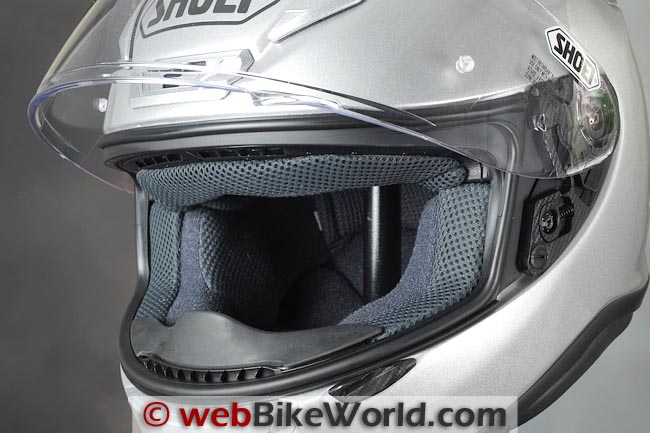
Miscellaneous
The RF-1200 has a double D-ring chin strap retainer and adequate padding. Shoei has a five year warranty from the purchase date or seven years from the manufacture date, whichever comes first.
| webBikeWorld Overall Opinionator: Shoei RF-1200 | |
|---|---|
| Picks… | …and Pans |
|
|
Conclusion
The new Shoei RF-1200 raises the bar for build quality, no doubt about that. The fit and finish on this one are outstanding and I simply cannot find a flaw. The ventilation isn’t quite as good as I’d hoped, however, and the noise levels, which are acceptable on a “naked” bike, are rather disappointing when riding a motorcycle with a windscreen that directs air at the helmet. The GT Air beats the RF-1200 “by a country mile” in both regards.
I think the RF-1200 is a noticeable improvement over the RF-1100, but perhaps not enough to entice recent RF-1100 buyers to switch.
RF-1000 owners, who are about due for a new helmet, may find the RF-1200 to be a revelation (with the caveat that my RF-1000 seemed to have more of a “Neutral” fit than the RF-1200).
My bottom line? I certainly like the build quality and looks of the RF-1200 but overall, I think the GT Air is the better helmet and it’s head and shoulders above any other helmet we’ve reviewed in 2013.
If you can swing $486.00 for the RF-1200, then surely you can go for the extra 65 bucks and get the GT Air. It has the same basic internal shape, much better ventilation and it’s much quieter. Plus, it has the internal sun visor with its special design.
However, it’s not Snell certified, although that may be a plus to some riders.
Also: wBW Shoei Helmet Reviews
| wBW Product Review: Shoei RF-1200 Helmet | |
|---|---|
| Manufacturer: Shoei Helmets | List Price: $485.99-$589.99. |
| Colors: Solids and graphics. | Made In: Japan |
| Sizes: XS-2XL Shell Sizes: Four | Review Date: October 2013 |
|
Rating Scale is subjective: Unacceptable, Poor, Neutral, Very Good, Excellent, Outstanding.
|
|
Owner Comments and Feedback
See details on submitting comments.
From “B.C.” (March 2017): “Just read your review on the RF-1200 (NXR here in UK). Disagree with your bit on the noise levels.
I have a MA Vario screen with spoiler on my Honda CB500F which directs the wind to the top half of my helmet.
With all vents closed there is no noise at all and with the front intake open there is a little noise but of no consequence , whilst this vent demists perfectly.
It is the quietest helmet I have ever owned and overall the best I have had. Enjoy all your tests!”
From “G” (March 2016): “I perused the Shoei RF-1200 review, thank you for it! When you look at a list of features (as you point out) the Shoei GT air easily beats it.
However, the special thing about the RF-1200 (I eyeballed it on a shelf in a shop) is it looks to be the smallest full face helmet made by Shoei — maybe the smallest full face helmet period.
For some people who worry about looking like an astronaut in a huge helmet, they will still choose the RF-1200 over more fully featured helmets at a similar price because of this unique slimmed down size of the RF-1200.”
Editor’s Reply: Shoei uses more shell sizes than anyone else, so they have a tighter head size to shell size ratio, which makes the shells look smaller.
Some of the other manufacturers – like SCHUBERTH – use only 2 shell sizes to span the entire range. So if you’re the smallest head size in the larger shell, the shell can look huge.
Happens to me all the time, I’m between an L and XL, so if I take the XL, that’s usually where the larger shell size starts. If the sizes go up to 2XL or 3XL, then a mere size XL head in the big shell will make the shell size seem huge.
From “L.B.” (July 2014): “Your review was accurate — except for one thing — Shoei fit (purchased online).
The struggle to get it on my head, side pads are very, very difficult to get head and ears into helmet, after that struggle, mouth and lips are pressed together in a very strange manner – not at all what I had expected.
In the course of the day riding many stops — helmet off and on — I can not put up with this nonsense. Shoei wants another $49. for smaller cheek pads (and no idea if t his will help).
Editor’s Reply: This is why it’s always important to try on a helmet before you buy it (and the webBikeWorld affiliate retailers have very liberal return policies.
It’s also crucial to match your head shape to the helmet’s internal shape and also to make sure the sizing is correct for your head size.
Some helmets have a tighter opening around the bottom and this is usually the case with the race and sport helmets like the RF-1200.
Also, this may be one way that the Shoei multiple shell size may work against you, because the shell size and head size differences are much closer.
So if your head is at the limit in size and shape for one shell/head size, you may need to go to the next size up and then install thicker cheek pads and liner. Trying the different size helmets on in the store can give you this feedback.
In any case, many times it is necessary to customize the helmet with different thickness cheek pads and/or liner. You may be able to do this with yours to tailor the fit.
From “K.G.” (July 2014): “Just wanted to let you know that I just fitted my Sena SMH-10 (review) to the Shoei RF1200. I read that it was best to use the adhesive mount but I had no difficulty with the clamp. I put the unit in the cut out just behind the shield.
The shape of the helmet means that the unit is almost horizontal when I’m on my sport tourer (Triumph ST1050). Speakers are a tight fit in the pockets.
Even so I was able to peel the foam from the covers and refit the thin cover using the clips.
I’ve fitted the Sena to several helmets including the RF-1100 (review), HJC SyMax 3 (review), a couple of dirt helmets and even a couple of ski helmets. This was the easiest and neatest installation.”
Editor’s Note: We were also able to fit the Cardo SHO-1 intercom (review) to the RF-1200.
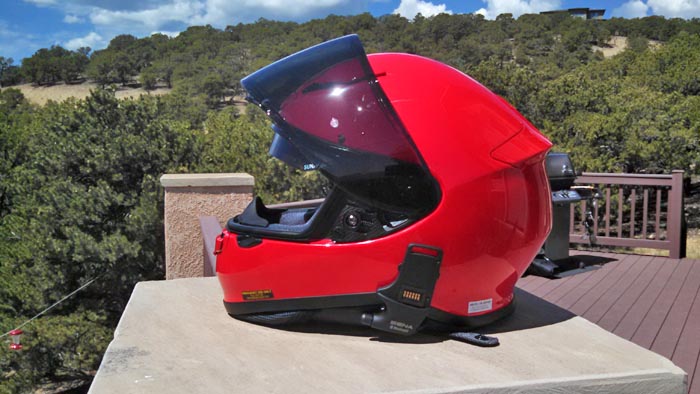
From “U.A.” (December 2013): “Firstly, as a regular reader who would not dare to think about purchasing new gear without reading your reviews first, I wish to say thanks!
My 4 years old Shoei RF1100 still looks and feels like brand new, but I am already starting to think of replacing it. I was thinking of the Neotec (review) and GT-Air (review) but now also the 1200 is an option.
To the point: I read your excellent review and encountered our Shoei RF history doubt (“I’m not sure if there were RF-200 to RF-700 helmets”) and wanted to fill in the info.
Yes, there was an RF-200 helmet. it was my first Shoei. You can clearly see it in the attached photo from 1994.”
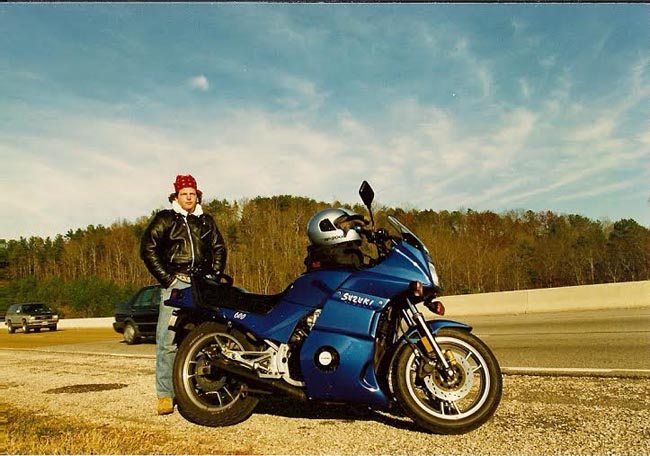
From “A.B.” (October 2013): “I have a Shoei RF-1000 (review) which has served me well. I tried on aShoei RF-1100 (review) and found they changed the eyeglass channels.
For whatever reason, it seems the channels are angled up so when I slide my glasses in it feels the ends of my glasses are about a half inch above my ear. Pretty much made the helmet useless.
Now, I don’t know if I just have a strange shaped head because I’ve never heard of anyone else complain of this on the RF-1100.
When you were wearing the RF-1200 with glasses how did your glasses actually fit on your face? Were they straight? Angled?
The real test is when I can put one on my own head to see but I am curious if Shoei changed the eye glass channels again or stuck with the RF-1100 design.
Thanks in advance, and you guys have one of the best resources for motorcycle reviews there is.”
Rick’s Reply: I am able to squeeze both my standard straight temple eyeglasses into the RF-1200 and I can also fit the Randolph Engineering Aviator (review) prescription sunglasses I wear.
It takes a bit of fiddling because my round head is a snug fit in the narrower RF-1200, but it works, no problem.
I do know exactly what you mean about the glasses tilting either up or down, this happens to me in different helmets and I’m never sure why, I guess it has to do with the inside side profile match to my head fit and/or the design of the ear pockets.
That said, because I could get my eyeglasses in the RF-1200 — which was a surprise actually because the helmet is tight for me on the sides — doesn’t necessarily mean you’ll have the same luck!
Also, I think the RF-1200 internal shape has been changed slightly from the RF-1000, so you may want to try one on first. I used to wear a size XL RF-1000 as my everyday helmet.


